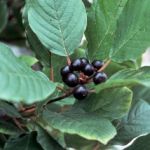| Common Name: |
Calabar Bean |
| Other Names: |
Chop Nut, Esere bean, Ordeal bean |
| Botanical Name: |
Physostigma venenosum |
| Genus: |
Physostigma |
| Family: |
Fabaceae |
| Native Location: |
Tropical W. Africa |
| Cultivation: |
Rich, well-drained soil in sun. |
| Propagation: |
By seed sown when ripe. |
| Harvest: |
Seeds are collected when ripe, mainly in the rainy season, and dried for use in decoctions and for extractions of alkaloids. |
| Height: |
15m (50ft) |
| Width: |
Indefinite |
| Hardiness: |
Min. 15-18°C (59-64°F) |
| Parts Used: |
Seeds (with outer coat removed) |
| Properties: |
A narcotic herb that depresses the central nervous system, mimics the parasympathetic nervous system, contracts the pupil of the eye, raises blood pressure, and stimulates peristalsis. |
| Medicinal Uses: |
As physostigmine, internally for neuromuscular diseases (notably myasthenia gravis), and post-operative constipation; externally as eye drops (especially for glaucoma). Formerly used in the treatment of tetanus, epilepsy, and rheumatism.
To treat glaucoma; to stimulate the peristaltic movements that move food through the digestive tract; as an antidote for poison. |
| Typical Dose: |
A typical dose of calabar bean in the form of physostigmine eye drops may range from 1 to 2 drops taken three times daily. |
| Possible Side Effects: |
Calabar bean is very poisonous, and can even be poisonous as eyedrops when they are inappropriately administered. Symptoms of poisoning may include nausea, diarrhea, vomiting, salivation, exhaustion, chills, dizziness, and muscle paralysis. |
| Drug Interactions: |
| Taking calabar bean with these drugs may interfere with the action of the drugs: |
| Atropine, (Isopto Atropine, Sal-Tropine) |
Benztropine, (Apo-Benztropine, Cogentin) |
Clidinium and Chlordiazepoxide, (Apo-Chlorax, Librax) |
Cyclopentolate, (Cyclogyl, Cylate) |
| Dicyclomine, (Bentyl, Lomine) |
Glycopyrrolate, (Robinul, Robinul Forte) |
Homatropine, (Isopto Homatropine) |
Hyoscyamine, (Hyosine, Levsin) |
| Hyoscyamine, Atropine, Scopolamine, and Phenobarbital, (Donnatal, Donnatal Extentabs) |
Ipratropium, (Atrovent, Nu-Ipratropium) |
Oxitropium, (Oxivent, Tersigat) |
Prifinium, (Padrin, Riabel) |
| Procyclidine, (Kemadrin, Procyclid) |
Propantheline, (Propanthel) |
Scopolamine, (Scopace, Transderm Scop) |
Tiotropium, (Spiriva) |
| Tolterodine, (Detrol, Detrol LA) |
Trihexyphenidyl, (Artane) |
Trimethobenzamide, (Tigan) |
|
| Disease Effects: |
May exacerbate or interfere with the treatment of asthma, diabetes, cardiovascular disease, Parkinson's disease, gangrene, slow heart rate, and intestinal obstructions. |
| Warning: |
Excess causes muscular weakness, respiratory failure, and cardiac arrest. For use by qualified practitioners only. |
| Bibliography: |
Encyclopedia of Herbs by Deni Brown Copyright © 1995, 2001 Dorling Kindersley Limited Pg 314
The Essential Herb-Drug-Vitamin Interaction Guide by Geo. T. Grossberg,MD and Barry Fox,PhD Copyright©2007 Barry Fox,PhD. Pp.113-114 |

